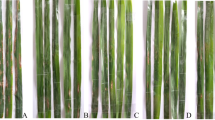Abstract
An experiment was conducted to introduce the entomopathogen Beauveria bassiana (Balsamo) Vuillemin (Ascomycota: Hypocreales) as an endophyte in jute (Corchorus olitorius), a bast fibre crop through seed treatment. Colonization of root, leaf, stem, capsule, and seed were assessed through plating on selective medium and PCR based detection using B. bassiana specific SCAR markers. Endophytic colonization was detected in all the plants grown from treated seeds, but all the plant parts were not colonized. Colonization was detected in leaves, stems, and green capsules but not in roots and seeds. The endophytic colonization was influenced by both plant part and sampling period. Colonization was greater in leaves (55.87%) compared to stems (12.53%) and capsules (42.44%). The percent colonization was higher in case of 60 days old plants (43.34%) than in 30 days (23.89%) and 120 days (35.39%) old plants. As B. bassiana has already been reported to be pathogenic on jute pests, namely semilooper (Anomis sabulifera) and bihar hairy caterpillar (Spilosoma obliqua), its season long endophytic colonization within jute plant suggests a novel approach of biological control of these pests through seed treatment with the entomopathogen.



Similar content being viewed by others
References
Akello J, Dubois T, Gold CS, Coyne D, Nakavuma J, Paparu P (2007) Beauveria bassiana (Balsamo) Vuillemin as an endophyte in tissue culture banana (Musa spp.). J Invertebr Pathol 96:34–42
Akello J, Dubois T, Coyne D, Kyamanywa S (2008) Endophytic Beauveria bassiana in banana (Musa spp.) reduces banana weevil (Cosmopolites sordidus) fitness and damage. Crop Prot 27:1437–1441
Arnold AE, Lewis LC (2005) Ecology and evolution of fungal endophytes, and their roles against insects. In: Vega FE, Blackwell M (eds) Insect-fungal associations: ecology and evolution. Oxford University Press, New York, pp 74–96
Bing LA, Lewis LC (1991) Suppression of Ostrinia nubilalis (Hubner) (Lepidoptera: Pyralidae) by endophytic Beauveria bassiana (Balsamo) Vuillemin. Environ Entomol 20:1207–1211
Castrillo LA, Vandenberg JD, Wraight SP (2003) Strain-specific detection of introduced Beauveria bassiana in agricultural fields by use of sequence-characterized amplified region markers. J Invertebr Pathol 82:75–83
Chase AR, Osborne LS, Ferguson VM (1986) Selective isolation of the entomopathogenic fungi Beauveria bassiana and Metarhizium anisopliae from an artificial potting medium. Fla Entomol 69(2):285–292
Cherry AJ, Banito A, Djegui D, Lomer C (2004) Suppression of the stemborer Sesamia calamistis (Lepidoptera; Noctuidae) in maize following seed dressing, topical application and stem injection with African isolates of Beauveria bassiana. Int J Pest Manag 50(1):67–73
Doyle JJ, Doyle JL (1990) Isolation of plant DNA from fresh tissue. Focus 12:13–15
Feng MG, Poprawski TJ, Khachatourians GG (1994) Production, formulation and application of the entomopathogenic fungus Beauveria bassiana for insect control: current status. Biocon Sci Technol 4:3–34
Gómez-Vidal S, Lopez-Llorca LV, Jansson HB, Salinas J (2006) Endophytic colonization of date palm (Phoenix dactylifera L.) leaves by entomopathogenic fungi. Micron 37:624–632
Gurulingappa P, Sword GA, Murdoch G, McGee PA (2010) Colonization of crop plants by fungal entomopathogens and their effects on two insect pests when in planta. Biol Control 55:34–41
Jones KD (1994) Aspects of the biology and biological control of the European corn borer in North Carolina. Ph.D. thesis, Department of Entomology, North Carolina State University, USA
Khan MSY, Bano S, Javed K, Mueed MA (2006) A comprehensive review on the chemistry and pharmacology of Corchorus species—a source of cardiac glycosides, triterpenoids, ionones, flavonoids, coumarins, steroids and some other compounds. J Sci Ind Res 65:283–298
Kundu BC (1956) Jute—world’s foremost bast fibre, II. Technology, marketing, production and utilization. Econ Bot 10(3):203–240
Ling J, Ling KLE, Chan KW, French GL (1987) Computer programs for accurate determination of size of DNA fragments in agarose gels. J Clin Pathol 40:692–695
Murray MG, Thompson WF (1980) Rapid isolation of high molecular weight plant DNA. Nucleic Acids Res 8(19):4321–4326
Pandit NC, Som D (1988) Culture of Beauveria bassiana and its pathogenicity to insect pests of jute (Corchorus capsularis and C.olitorius) and mesta (Hibiscus cannabinus and H. sabdariffa). Indian J Agr Sci 58(1):75–76
Posada F, Vega FE (2005) Establishment of the fungal entomopathogen Beauveria bassiana (Ascomycota: Hypocreales) as an endophyte in cocoa seedlings (Theobroma cacao). Mycologia 97:1195–1200
Posada F, Aime MC, Peterson SW, Rehner SA, Vega FE (2007) Inoculation of coffee plants with the fungal entomopathogen Beauveria bassiana (Ascomycota: Hypocreales). Mycol Res 111:748–757
Rahman S, Khan MR (2007) Pest complex of jute and their management. In: Prasad D (ed) Sustainable pest management. Daya Publishing House, Delhi, pp 352–372
Roy S (2010) Jute basics. International Jute study Group, Dhaka, pp 9–12
Shah PA, Pell JK (2003) Entomopathogenic fungi as biological control agents. Appl Microbiol Biotechnol 61:413–423
Tefera T, Vidal S (2009) Effect of inoculation method and plant growth medium on endophytic colonization of sorghum by the entomopathogenic fungus Beauveria bassiana. BioControl 54:663–669
Vega FE, Posada F, Aime MC, Pava-Ripoll M, Infante F, Rehner SA (2008) Entomopathogenic fungal endophytes. Biol Control 46:72–82
Wagner BL, Lewis LC (2000) Colonization of corn, Zea mays, by the entomopathogenic fungus Beauveria bassiana. Appl Environ Microbiol 66:3468–3473
Acknowledgments
We acknowledge the support provided by Prof. B. S. Mahapatra, Director, the Central Research Institute for Jute and Allied Fibres, Barrackpore, Kolkata, India. We also appreciate the comments of the two anonymous reviewers.
Author information
Authors and Affiliations
Corresponding author
Additional information
Handling Editor: Helen Roy
Rights and permissions
About this article
Cite this article
Biswas, C., Dey, P., Satpathy, S. et al. Establishment of the fungal entomopathogen Beauveria bassiana as a season long endophyte in jute (Corchorus olitorius) and its rapid detection using SCAR marker. BioControl 57, 565–571 (2012). https://doi.org/10.1007/s10526-011-9424-0
Received:
Accepted:
Published:
Issue Date:
DOI: https://doi.org/10.1007/s10526-011-9424-0




